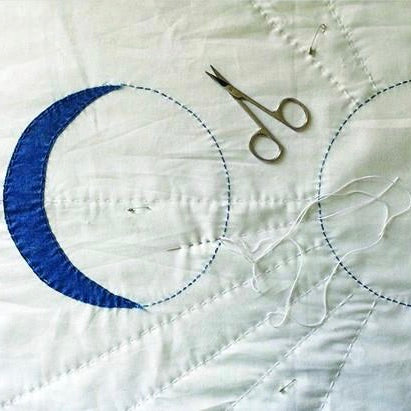To longtime New Yorkers, the beauty and serenity of the Hudson Valley is no secret. The landscape has always been conducive to the creative processes of artists. Now more than ever, out-of-staters are increasingly calling it home, and finding that the region offers just what they need to flourish.
One such artist is Alison Smith, or Ali, as most of us call her. Ali relocated late last summer from Jersey City to the Hudson Valley. Experimenting in all areas of textile art, Ali is an incredibly prolific maker. She runs Salt & Still, a successful one-woman business for which she does everything from designing and hand-producing, to social media marketing and shipping out sales. As stated in the biography on her website, Ali’s main areas of expertise are in “natural dyes and and sashiko style stitching,” but her contributions to these fields are understated. She is an informative and patient teacher, hosting various year-round workshops throughout the region in indigo and shibori dyeing, fiber jewelry making, natural dye swatches, sashiko and visible mending, and hand quilting.
We recently checked in with Ali to see how she was settling into her new home in New York State and also asked her to teach us how to make a cozy quilt for our New York "Cozy" State of Mind. Ali kindly provided us with a simple “how-to” hand quilting guide. Read the full interview below!
New York Makers: In what town do you currently reside?
Alison Smith: Peekskill, New York.
NYM: What do you love about it?
Alison Smith: I just moved to Peekskill in August [2016], so I’m still new to the area. I love the proximity to nature and that I can go for daily hikes with my dog. Also the view of the Hudson [River] from the Peekskill waterfront can’t be beat.

NYM: Can you share one obscure visitor’s tip?
AS: I just learned that Peekskill has its own New Year’s Eve countdown, ball drop and fireworks! And on New Year’s Day there’s a Polar Plunge in the Hudson River (I only watched, I didn’t join in!).
NYM: What made you move from New Jersey to New York?
AS: I loved living near the city, but I reached a point where I needed to be closer to nature and have more workspace. Peekskill has certified artist housing, which I am lucky enough to live in, so now I have a great studio space and can be on a hiking trail in minutes.
NYM: How did you learn to quilt?
AS: The first quilt I made was using [Brooklyn-based] Haptic Lab’s DIY constellation quilt kit, and I would recommend Haptic Lab kits to any first time quilters. Everything else I’ve learned has been self-taught using vintage quilting books and the internet as resources.

NYM: In your beginners' guide to hand quilting, what are the basic materials one needs?
AS: At least two pieces of fabric, batting, needle, quilting or sashiko thread, bias tape, scissors, ruler, safety pins and a chalk pencil.

NYM: Can you give us a simple step-by-step for say, a mini-quilt?
AS: Choose your top piece of fabric, bottom piece of fabric, batting, and binding tape. Patchwork or add any applique or decorative stitching to the top piece of fabric. Baste the quilt by laying the bottom fabric down first, followed by batting, and then the top piece. Safety pin through all three layers to prevent them from shifting when you begin hand quilting. Draw out lines with a chalk pencil where you want to hand quilt or free hand stitch. Make sure your hand quilting goes through all three layers. A simple running stitch is an effective and lovely way to hand quilt. Bind your quilt with bias tape to finish it using either a visible or blind stitch.

NYM: Any normal mishaps for a first-timer and tip for how to avoid them when picking up the needle next?
AS: It’s easy for your quilt to not remain flat when you’re basting which can lead to bubbles and un-smooth areas in your finished piece. A good tip I learned to prevent this is to lay down the bottom piece of the quilt, make it very flat and tape it down. Repeat this with the batting and top layer. The tape should help maintain the flatness of all three layers when you baste and begin hand quilting.
All photos are courtesy of Alison Smith.

Leave a comment